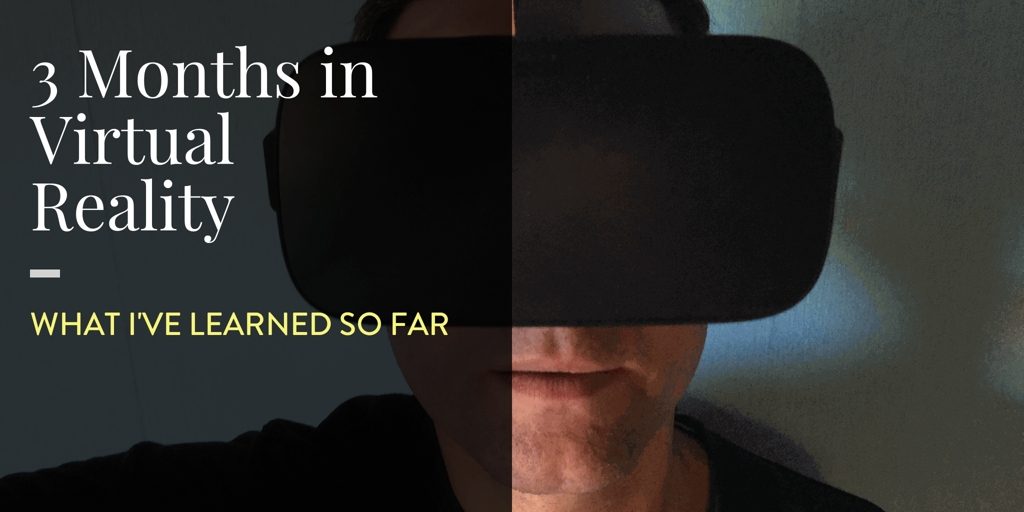3 Months in Virtual Reality, 6 Lessons Learned

I can vividly remember my first VR experience. It was 25 years ago!
It was early 90’s. I was a teenager addicted to video games. When I wanted more sensation than my Game Boy could provide, there was only one option: the arcade hall. My favorite happy place took my pocket money piece by piece.
I didn’t have a lot of pocket money, so I selected the game economically. The longer I played the same game the better I got and the more value I received out of a coin. Of course, I noticed the attractive big double coin machines like Out Run and After Burner. They looked amazing but too expensive.
Until… Suddenly, out of nowhere, they had this new machine installed. A huge installation. It was guarded 24×7 by an operator and the cost were a whopping five guilders to play. It was an actual Virtual Reality experience. Some kind of shooter, where you could walk through some kind of platform. It looked like this. I was hooked! This was the future of gaming. Little did I know I had to wait 25 years for my next VR experience.
25 years later
In 2016, the first real commercial VR systems (Oculus, HTC Vive) hit the market with a mainstream strategy. Early adopters have to pay top dollar to satisfy their need for innovations but really can’t help themselves. I simply needed to get my hands on the first Oculus Rift. The rift alone is a fairly reasonable investment for $599, but the PC needed to run smoothly starts around $1750. I’m a mac user, so I needed to buy a dedicated PC to get started.  I’m still waiting for $150 discount from Oculus Rift, but let’s say their service levels are just as young as their product.
The good news is that more systems and accessories are coming soon and prices will go down quickly. PlayStation is next and releases a VR set that is expected at $399. That will be a big step towards global acceptance of VR.
By the way, if you like to try it out for less, you can look into Samsung Gear or Google Cardboard or similar devices. Albert Heijn, a huge Dutch retailer, recently introduced AR and VR to every kid in the Netherlands. Again an impressive operation that smoothly introduces VR to a large population.
So, what have I learned?
So now I finally have my own VR setup at home. I’ve spent many hours in VR. I visited the Himalaya. I went to Pluto. I’ve had front row seats (and better) in concerts and I’ve been inside games like never before. But I’ve learned more:
- VR is a quantum leap forward in entertainment. Only the first-time showing to friends and family is already worth the investment. Every single first-timer has the same reaction: complete amazement by the immensity of today’s possibilities and that leads to interesting discussions afterward about the impact of VR on our world and perspectives.
- VR is enlarging generation gaps. Let me explain it this way:
- My dad (65) is actually pretty up to speed with technology, but he barely moved around in VR. His brain witnessed VR, but didn’t embrace VR as a reality. An anachronism observed as an immersive 3D movie. Since then he never requested to go in VR again.
- My 12-year-old niece immediately made the virtual world her own. She moved around as if she lived there. She didn’t want to stop and has a VR set on top of her wish list now.
- My 4-year-old son simply accepted alternative realities as normal and wanted to switch between them like it’s a TV with 58 channels. The idea that his generation will be able to switch realities, like generation Z is switching apps, is mind boggling.
Some people are frustrated when their kids use smart phones at the dinner table. Well, with a smart phone they are at least at the dinner table. VR will put them somewhere else. This vivid and colorful difference of generations perspectives of technology’s impact on reality is fascinating.
- The disconnect from your social environment is huge. This is the biggest barrier for mainstream use of VR. If I spent an evening in VR, my family sees my body standing in a room, but I’m not there. Like a zombie, who doesn’t want to dispel the magic. This disconnect from your social environment is intriguing, because paradoxically, the very absence of it makes to understand how important social connections actually are.
- VR will be its own solution for this gap in social connectivity. But it takes time. There are already different social platforms where you can connect with other VR users. The quality of those is disappointing. Especially when you realize that the Oculus Rift is owned by Facebook. They know a thing or two about social communities. But… it’s not too difficult to imagine how it will look in the near future when more senses get involved. The possibility to touch will be the next step. Or will it be smell?
- The Philosophical perspective is awesome. VR is the closest thing you can get to the matrix. It makes your current/existing reality relative when you are able to easily switch between realities. Morpheus would say: an unlimited supply of blue pills.
- The last eye-opener is the power of your eyes as mouse/pointer. In VR you don’t use a mouse, you simple look at something and click on your controller. It’s amazing to see how intuitively you can navigate with your eyes. An Eye Opener. Literally.
Conclusion
VR transfers everything in an upgraded 2.0 version. Whether it is learning, programming, dating, sex, movies, games or other entertainment. The potential is limitless and exceptionally interesting for companies to create services and products and for consumer to enjoy life in different ways.
I can only recommend to investigate and play with VR as soon as you can. It is mind blowing, eye opening and it will rock your senses.
It’s one of these things that you can talk about as much as you like, but you are unable to truly explain the experience with words. Like love, like being a parent. You can only experience it for yourself. And once you do, you’ll be generating a new paradigm. One that drives innovation. One that is just getting started.
Wait! Before you go…
Choose how you want the latest innovation content delivered to you:
- Daily — RSS Feed — Email — Twitter — Facebook — Linkedin Today
- Weekly — Email Newsletter — Free Magazine — Linkedin Group
 Patrick Willer is a Workforce Innovation Consultant at SAP. He is intrigued by people: How we think, connect, and create together. This is what inspires his learning, and informs his business career in Human Capital Management. Patrick specializes in creativity, innovation, social collaboration, and solution-focused planning and execution of strategies impactful to Human Capital Management. Follow or connect with Patrick @PattWiller
Patrick Willer is a Workforce Innovation Consultant at SAP. He is intrigued by people: How we think, connect, and create together. This is what inspires his learning, and informs his business career in Human Capital Management. Patrick specializes in creativity, innovation, social collaboration, and solution-focused planning and execution of strategies impactful to Human Capital Management. Follow or connect with Patrick @PattWiller
NEVER MISS ANOTHER NEWSLETTER!
LATEST BLOGS
The Importance of Packaging
Let’s talk about packaging. Packaging can be thought about in many different ways, but if we think purely about the purpose of packaging first, we find the purpose is to: contain the product, communicate product information, …
Read MoreWhy the World Cup is a Big Deal
After living overseas in Germany and England and now coming back to the United States, I have a completely different perspective on Football (or Soccer as we call it in the United States). With the World Cup in full swing, I thought I would tackle the subject of Football and why it is the most popular sport in the world.
Read More


